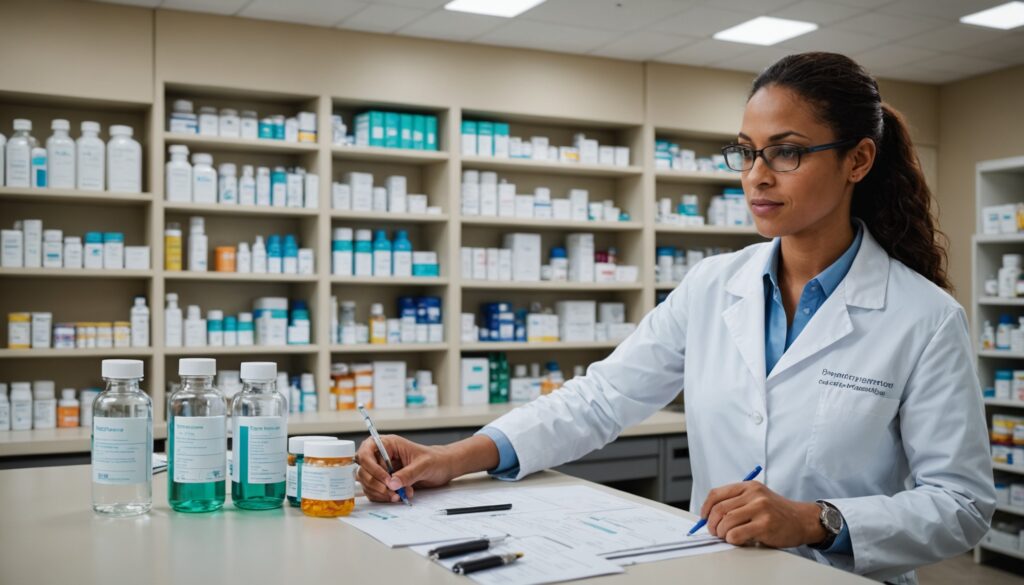GLP-1 meds mimic a natural gut hormone called glucagon-like peptide 1. That hormone boosts insulin release after you eat and slows stomach emptying so you feel fuller.
Doctors often prescribe these injectable drugs to help manage type 2 diabetes and support weight loss. Brands like Ozempic, Wegovy, and Trulicity come in prefilled pens with fixed doses. That setup works for many patients, but not everyone fits neatly into those dosage boxes.
If your healthcare provider wants to fine-tune your dose or try a different delivery form, you may hear about custom GLP-1 treatments from compounding pharmacies. Let’s break down how those work and whether they’re a safe choice for you.
What Compounding Pharmacies Do
Compounding pharmacies create tailor-made medications based on a doctor’s order. Instead of dispensing a one-size-fits-all brand product, they mix raw active ingredients to match your unique needs.
Here’s the process in a nutshell:
- Your provider sends a prescription specifying dosage, form, and any special instructions.
- The pharmacy sources the API (active pharmaceutical ingredient) and combines it with stabilizers or carriers.
- Technicians fill syringes, capsules, or creams according to precise calculations.
These specialty pharmacies follow state board rules and professional guidelines. They don’t go through the same FDA approval pathway as commercial drugs, but they must adhere to quality standards set by organizations like the United States Pharmacopeia.
Legitimacy of Compounded GLP-1
Most compounded GLP-1 drugs on the market are legitimate, custom-made by licensed pharmacies to serve patients who need flexible dosing or alternative delivery options. However, they may not undergo the same regulatory scrutiny as brand-name products, which can introduce variability in strength and purity.
Because compounding pharmacies aren’t required to submit every formula to the FDA, there’s some variability in how they operate. That said, many follow strict protocols to ensure accuracy, stability, and sterility.
Benefits of Tailored Prescriptions
When you opt for a compounded GLP-1 medication, you unlock several perks that standard products may not offer:
- Dosage customization
- Your doctor can order any dose, large or small, even ones not sold in prefilled pens. That helps patients who need incremental adjustments.
- Alternative delivery methods
- If you’re needle-averse or need a topical option, some pharmacies can craft creams or oral capsules.
- Addressing side effects
- Compounding can remove nonessential fillers or preservatives you might react to.
- Enhanced availability
- When brand products sell out, compounding pharmacies may still have raw ingredients on hand.
- Potential cost savings
- Custom formulas sometimes come with lower co-pays or cash prices if generics are used.
These advantages make compounding a helpful option if you’ve hit a dosing plateau, can’t tolerate additives, or face supply shortages.
Risks of Custom Formulations
So is a compounding pharmacy risk-free? Not quite. Here are a few caveats to keep in mind:
- Variability in potency
- Small measurement errors can lead to doses that are stronger or weaker than intended.
- Contamination risks
- Poor sterility practices may introduce bacteria or particulates into injectables.
- Limited clinical data
- Custom formulas rarely undergo large-scale trials, so long-term safety isn’t as well studied.
- Insurance coverage
- Some plans won’t cover compounded medications or may require extra approvals.
- Regulatory gray areas
- Oversight varies by state, so pharmacies in one region might operate under looser rules than another.
Before you commit, weigh these risks against the benefits. Talk openly with your provider about any concerns you have regarding potency, purity, or side effects.
Choosing a Safe Pharmacy
Picking a reputable compounding pharmacy is key to reducing risks. Here’s how to vet your options:
- Verify credentials
- Check that the pharmacy is licensed by your state board of pharmacy.
- Look for technicians and pharmacists with certification in sterile compounding.
- Ask about quality standards
- Inquire whether they follow USP chapters (795 for nonsterile, 797 for sterile).
- Request proof of routine potency and contamination testing.
- Analysis sourcing information
- Ensure the pharmacy uses high-quality, FDA-registered ingredient suppliers.
- Avoid companies that won’t disclose their raw material sources.
- Read patient feedback
- Search online reviews or ask your doctor for testimonials.
- Watch for consistent praise or red flags around sterility and accuracy.
- Consult your healthcare team
- Ask your physician or pharmacist to recommend trusted compounding providers.
- Keep them in the loop on any new formula you’re considering.
Taking these steps helps you find a compounding pharmacy that plays by the rules and puts patient safety first.
Key Takeaways and Actions
- Compounded GLP-1 medications offer flexible dosing, alternate formats, and help during shortages.
- They skip full FDA approval, so quality and potency can vary from one pharmacy to another.
- Always verify licensing, quality controls, and ingredient sourcing before you order.
- Discuss your options and any fears with your healthcare provider to choose the best path forward.
Ready to explore a custom GLP-1 solution? Start by calling your doctor and asking for a compounding prescription if standard pens aren’t working for you. If you’ve tried a compounding pharmacy already, share your experience in the comments below to help others make informed decisions.

